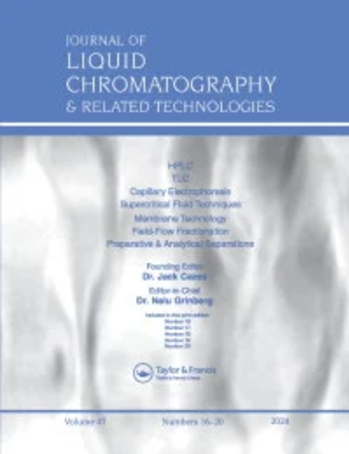4-肼-7-硝基苯的柱前荧光衍生高效液相色谱法测定化妆品中丙酸氯倍他索[C][1,2,5]恶二唑
IF 1.2
4区 化学
Q4 BIOCHEMICAL RESEARCH METHODS
Journal of Liquid Chromatography & Related Technologies
Pub Date : 2022-12-14
DOI:10.1080/10826076.2023.2194967
引用次数: 0
摘要
摘要本研究合成了一种荧光标记试剂4-肼基-7-硝基苯[c][1,2,5]恶二唑(NBD-NHNH2),并将其用于化妆品中丙酸氯倍他索的高效液相色谱荧光检测。在酸性催化剂(pH = 6.0)存在下,NBD-NHNH2在45℃下反应30min,丙酸氯倍他索可以快速有效地标记。这些衍生物具有优良的稳定性和荧光性能。最大激发波长为450 nm,最大发射波长为550 nm。采用Waters e2695高效液相色谱C18柱梯度洗脱,将四种化妆品配方完全分离。在最佳条件下,标准曲线具有良好的线性响应,相关系数r2 = 0.9999。检出限和定量限分别为0.01 ng/mL和0.03 ng/mL。因此,NBD-NHNH2成功应用于化妆品中非法添加丙酸氯倍他索的检测。图形抽象本文章由计算机程序翻译,如有差异,请以英文原文为准。
Determination of clobetasol propionate in cosmetics by high performance liquid chromatography with pre-column fluorescence derivatization of 4-hydrazino-7-nitrobenzo [C] [1,2,5] oxadiazole
Abstract In this study, a fluorescent labeling reagent 4-hydrazino-7-nitrobenzo [c] [1,2,5] oxadiazole (NBD-NHNH2) was synthesized and used for fluorescence detection of clobetasol propionate in cosmetics by high performance liquid chromatography. In the presence of acidic catalyst (pH = 6.0), NBD-NHNH2 reacted at 45 °C for 30 min, and clobetasol propionate can be labeled quickly and efficiently. These derivatives have excellent stability and fluorescent properties. The maximum excitation wavelength was 450 nm, and the emission wavelength was 550 nm. The four cosmetic formulations were completely separated on a Waters e2695 HPLC C18 column by gradient elution. Under the optimal conditions, the standard curve showed a good linear response, and the correlation coefficient of r 2 = 0.9999. The LOD and LOQ were 0.01 ng/mL and 0.03 ng/mL, respectively. Therefore, NBD-NHNH2 was successfully applied in the detection of clobetasol propionate illegal added in cosmetics. Graphical Abstract
求助全文
通过发布文献求助,成功后即可免费获取论文全文。
去求助
来源期刊
CiteScore
2.80
自引率
0.00%
发文量
29
审稿时长
4.9 months
期刊介绍:
The Journal of Liquid Chromatography & Related Technologies is an internationally acclaimed forum for fast publication of critical, peer reviewed manuscripts dealing with analytical, preparative and process scale liquid chromatography and all of its related technologies, including TLC, capillary electrophoresis, capillary electrochromatography, supercritical fluid chromatography and extraction, field-flow technologies, affinity, and much more. New separation methodologies are added when they are developed. Papers dealing with research and development results, as well as critical reviews of important technologies, are published in the Journal.

 求助内容:
求助内容: 应助结果提醒方式:
应助结果提醒方式:


